| Republic of Finland Suomen Tasavalta Republiken Finland | |||||
|---|---|---|---|---|---|
|
|||||
| Motto: Pysyvä Kuin Kaikki, Suomi! |
|||||
| Motto: Standing After All, Finland! |
|||||
| Anthem: Maamme |
|||||
| Finland (Orange) in the Nordic Union (Green)
|
|||||
| Capital (and largest city) | Helsinki | ||||
| Official languages | Finnish, Swedish | ||||
| Regional languages | Sami, Romani, Karelian | ||||
| Ethnic groups | Finnish | ||||
| Demonym | Finnish · Finn | ||||
| Government | Parliamentary Republic | ||||
| - | President | Martti Ahtisaari | |||
| - | Prime Minister | Paavo Lipponen | |||
| Legislature | Parliament (Eduskunta or Riksdagen) |
||||
| Independence | |||||
| - | Autonomy within Russia |
29 March 1809 | |||
| - | Independence from the Russian SFSR |
6 December 1917 | |||
| - | First recognized by the Russian SFSR |
4 January 1918 | |||
| - | Joined Nordic Union | 26 September 1990 | |||
| Area | |||||
| - | 336,887 km2 130,073 sq mi |
||||
| Population | |||||
| - | TBD census | TBD | |||
| Currency | Nordic Krone (NUK) |
||||
| Drives on the | right | ||||
Finland, officially the Republic of Finland (Finnish: Suomen Tasavalta) is a Nordic country in north-eastern Scandinavia. Finland is geographically bordered by the Gulf of Bothnia to the west and the Gulf of Finland to the south. Finland shares borders with Sweden to the west, Norway to the north, Estonia to the south, and Socialist Siberia's Northwest Territory and Karelia to the east.
Finland is a founding member of the Nordic Union, along with the nations of Sweden, Norway, Iceland, and Denmark. Finland has since gone on to be involved in the creation of the Atlantic Defense Community and the League of Nations, through the Nordic Union.
History[]
The history of Finland is relatively unique in the Scandinavian region because the isolation of Finland from Germanic influences led to a unique, distinctly Finnish culture. Unlike Sweden, Denmark, and Norway, Finland uses a vastly different language.
Prehistory-1917[]
Finland was originally settled by Uralic and Baltic peoples, who were used to the cold climate, around 8500 BC. During the attempts of a Christian Sweden to convert pagans in Finland, Finland became a part of the Kingdom of Sweden. At this time, Swedish and Germanic influences began to pervade Finnish culture to the point where it is today. Finland, under the Swedish monarchy, grew to become predominantly Lutheran, a religious trait that most Finns still carry.
During the Finnish War or 1808-1809, Finland was lost by Sweden and ceded to Russia as a Grand Duchy of the Russian Empire. Finnish independence movements began around the same time as the Bolshevik and Soviet movements began to gain traction in Russia.
1917-1945[]

Finns in the Winter War
As World War I engulfed Europe, Russia broke into the Russian Revolution, which led to the Finnish Civil War. Germans, Swedes, and Estonians backed a "White Finland," while Communist "Red Finns" fought throughout the nation, including battles at Tampere and Helsinki.
Finland became a Presidential Republic in 1919, which led to an increase in positive relations between Western Europe and Finland. With the rise of Nazis in Germany, Finland began to distance itself from the USSR and move closer to Germany in particular.
The Finns fought in three wars during World War II. First, they defended against the Soviets in the Winter War (1939-1940), then they fought the Soviets as part of Operation Barbarossa in the Continuation War (1940-1941). Finally, after the Nazis were losing, the Finns switched sides and kicked a much larger Nazi army out of Finland in the Lapland War (1944-1945).
1945-1983[]
After World War II, Finland began to experience a period of relative economic success. This was the result of their neutrality, and therefore, ability to receive funds from both sides of the Cold War. Eventually, however, the Soviet Union ended up funding the Finns more than the Americans, leading to closer alliances with the Soviets.
The economic gains of Finland led to urbanization and a Baby Boom. During the 1960s-1970s many baby-boomers relocated to Sweden to find work. During the late 1970s, the Finnish government built a successful welfare state, leading to what is called the "Nordic Model."
Doomsday[]

Mauno Koivisto
Due to the Finnish neutrality in the Cold War, all of the Finnish cities and military installations were spared from a nuclear attack. This was the same fate of their neutral neighbor Sweden.
President Mauno Koivisto was in Washington D.C. at the outbreak of of Doomsday. He had spoken that day at a meeting of the IMF and was to go to New York the next day for a summit at the United Nations. By the time he was alerted that Soviet missiles were inbound, he attempted a last time phone call to contact the chief of defence Lauri Sutela, sadly enough the last sound of Mauno being "He..." before getting cut of and all contact lost.
Prime Minister Kalevi Sorsa was awakened at 4:15 in the morning, Helsinki time. He was informed that the nuclear annihilation of the world had begun and that, with Koivisto out of the country and likely dead, he was Acting President under Finnish law and was responsible for deciding the country's response. Sorsa immediately sought contact with the Soviet and American embassies in Helsinki.
As his aides sought explanations from the equally stunned ambassadors, Sorsa made contact with Olof Palme, the Prime Minister of Sweden. Both nations were spared in the nuclear holocaust, but both were already feeling the effects of radioactive fallout and electromagnetic pulse. While the Finnish cities were spared from nuclear devastation, some tracts of Finnish land became irradiated. This was especially common in the southern part of the nation, where nuclear blasts on Tallinn and Leningrad were really close to the Finnish border.
Following the atomic strikes, some electronic technology was damaged, but enough tech remained active throughout the crisis that the government-owned radio Yleisradio, could send regular news briefings. Radios were distributed throughout the later established refugee camps.
During the period directly after Doomsday, Finland's economy dropped, but the impact was not the utter catastrophe that had been predicted. Many of those unemployed by Doomsday were able to find employment in the military or government sponsored works programs. News of the attacks spread quite quickly through the publicly-owned television provider Yleisradio (Yle).
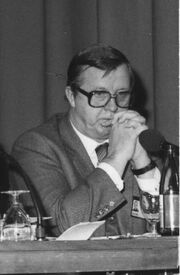
Acting President, later President, Kalevi Sorsa
1983-1990[]
With Finland spared the nuclear holocaust of the Third World War, Acting President Kalevi Sorsa would make sure that the Finnish nation would not collapse. His plans were soon tested, however, as refugees from Karelia, Russia, and what would later become the PSSRR, would surge along Finnish borders. With a minimalistic army, the Finnish army was not altogether successful in repelling formerly Soviet refugees, creating a larger Karelian and Russian minority in Finland.
Prior to Doomsday, large-scale planning for a Constitutional change was underway, and after a short period of time, it was decided by the Finnish Parliament that a new series of amendments to the Finnish Constitution would indeed be needed. In 1984 approved the Constitution, called the Uusi Konstituutio (New Constitution), was approved.
As a result of the Uusi Konstituutio, the government was reorganized into four branches, the Parliament, Presidency, Ministry, and Judiciary.
Sorsa's government judged it unwise to hold a special election during the emergency, so he continued to serve as Acting President for the remainder of Koivisto's term. In 1988, he was duly elected President in a regular election.
Throughout this time, the nations of Scandinavia did what they could to support one another, despite the neverending economic and humanitarian disaster. Sweden, Norway, and Finland remained close partners. Reluctant to work closely with ex-Soviets after the border war of 1983-4, the Finns didn't initiate formal relations with Karelia until 1996.
1990-2010[]

Nordic Union Flag
In 1990, the governments of Norway, Sweden, Denmark, and Finland all agree to join together and form the Nordic Union, an international economic and political union based on Nordic ideals. Finland and Sweden, the two strongest Nordic powers, were founding members.
The talks to form the NU affected Finland's territory. The autonomous island region of Åland had been left largely to take care of itself during the chaotic postwar years. The islands had relied on Sweden more than Finland for help patrolling its seas and restoring the rule of law. Ålandic representatives now asked the NU to support its independence. The compromise was near-independence: Finland would retain some check on Åland's policies, but the islands would no longer be considered integral Finnish territory. Åland became a Nordic Union member in 1991.
One major reason why the Nordic Union was founded was because of the dominance of the Kok. political party, which led a coalition in Parliament and was supportive of the Union, while the SMP was adamantly against forming it. The support for the Nordic Union, which was widespread, resulted in the relative decline of the SMP, and the meteoric rise of the Kok.; Sauli Niinistö was elected President in 1994 and 2000. In 2006, Esko Aho of Kesk was elected President after his party aligned itself with the Kok.

ADC Flag
In 2007, along with the other members of the Nordic Union, Finland was one of the co-founders of the Atlantic Defense Community, which is often viewed as the successor to the North Atlantic Treaty Organization. The decision to join the ADC was somewhat controversial as Finland had not been a member of NATO, but ties to the rest of the Nordic Union as well as the governing Kok.-Kesk coalition pressured the Finns into joining the alliance in a plebiscite.
2010-Present[]
Government[]
Immediately prior to the Doomsday catastrophe, the Finnish government under Acting President Kalevi Sorsa decided, at the suggestion of many advisors that a Constitutional change was needed. The original changes were only intended to be small procedural changes to the Finnish parliamentary procedure, but after Doomsday and the ensuing need for a stronger central government the whole of the Constitution came under scrutiny.
Constitution[]
The Finnish Constitution prior to Doomsday was a collection of laws that were collectively referred to as "Constitutional Law." Following Doomsday and the Uusi Konstituutio, which was ratified by the Parliament on March 23, 1984, a single document was proclaimed to be the nation's official constitution, which reduced the difficulty of the amendment process vastly, among other profound changes.
The Constitution created four main divisions of government. The four divisions are:
- The Finnish Parliament (Eduskunta), which is elected by a direct, secret ballot on the basis of proportional representation every four years.
- The President, who is elected by the general public every six years.
- The Ministry, which is appointed by the President at the recommendation of the Prime Minister.
- The Judiciary, which is in turn divided into two separate court systems, the Legal and Administrative Courts.
President[]
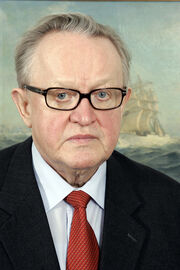
Martti Ahtisaari, current President of Finland (SDP)
The President is the second most-important political office in Finland, and is currently held by Martti Ahtisaari, of the SDP. The President is elected every six ears for a six year term, with a maximum of only one reelection, which must be immediately following the President's first term. The next Presidential election will take place in 2018.
The duties of the President include serving as Head of State. The President doesn't play a direct role in the function of the Eduskunta; the Prime Minister is in charge of legislative operations of the Republic.
The current President is Martti Ahtisaari, <<a noted SDP politician who rose to power as Mayor of Tampere from 1996-2008, and then served as Prime Minister from 2010-2012 before being elected to the Presidency.>>
- <<Must VALIDATE>>
Parliament[]
Called the Eduskunta by the Finns and the Riksdagen by Swedish-speaking Finns, the Parliament of Finland is delegated law-making powers under the Uusi Konstituutio.
The Eduskunta is made up of 200 Representatives that must be, as a minimum, be 24 years of age and have lived for at least 14 years in Finland, and 20 in the Nordic Union (a change made to the Uusi Konstituutio as part of the 1990 Amendments).
The primary responsibility of the Eduskunta is the legislation of the Finnish state. The legislation is introduced to the General Assembly of the Eduskunta by one of ten committees, each with ten members. These committees are assigned based upon seniority, with the higher committees assigned to more senior members. They are, in order of importance, and therefore seniority:
- Oversight Committee
- Foreign Affairs Committee
- Finance and Tax Committee
- Defence Committee
- Transportation and Infrastructure Committee
- Budget Committee
- Social Affairs and Health Committee
- Education and Culture Committee
- Media Committee
- Labor Committee
After legislation is introduced, the Prime Minister will call the bill to a vote, after which a majority vote will confirm the legislation into law.
Ministry[]
The Ministry, as the association of members of Parliament who make up the leadership of any given election cycle is called, is made up of ten Committee Ministers, two Deputy Prime Ministers, and one Prime Minister. The Prime Minister is the most important political figure in Finnish politics, as he controls the Parliament. The Prime Minister is elected at the start of an election cycle to serve for all four years of the cycle unless by a vote of no confidence he is removed from office.
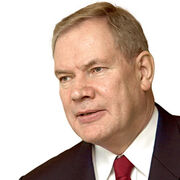
Prime Minister Paavo Lipponen
The ten Committee Ministers are then selected by the Prime Minister from among the members of the Parliament to head one of the ten Parliamentary Committees for the election cycle.
The current Prime Minister is Paavo Lipponen, a notable political figure from SDP. Lipponen has served as a member of Parliament since 1983, making him one of the most senior members of Parliament with 31 years of experience. Lipponen was elected Chairman of the SDP in 2004, as the old Chairman resigned. Lipponen's SDP then won a plurality of seats in the Parliament and managed to form a coalition government with Kesk. which remains in place to this day.
Judiciary[]
Legal Circuit[]
Administrative Circuit[]
Political Parties[]
The government of Finland is tightly controlled by a number of political parties, which then align with a larger grouping in the Nordic Law Thing. The four primary political parties (ones with representation at the Thing) are:
- Suomen Maaseudun Puolue (SMP)
- Nordic Conservatives bloc
- Finnish Rural Party
- Kansallinen Kokoomus (Kok.)
- Nordic Liberals bloc
- National Coalition Party
- Suomen Keskusta (Kesk)
- Nordic Centrists bloc
- Centre Party
- Suomen Sosialidemokraattinen Puolue (SDP)
- Nordic Social Democrats bloc
- Social Democratic Party
The current Prime Minister is Paavo Lipponen, of the SDP. He was elected as a result of the Finnish general election of 2011, and plans to represent his party in the Finnish general election of 2015.
SMP[]

Emblem of the SMP
The SMP, or Suomen Maaseudun Puolue is the Finnish Rural Party, is the Nordic Conservative bloc representative of the Republic of Finland. SMP traces its origins back to 1959, and is a populist and agrarian party, focusing on matters important to the farmers and rural poor of Finland.
SMP's leader is currently Timo Soini, who was a youth organizer around Helsinki at the time of Doomsday. The SMP's supports a welfare state that helps agricultural businesses as well as increased infrastructure spending.
The SMP is also dedicated to Finnish nationalism; while not calling for direct withdrawal from the Nordic Union, the SMP would prefer much greater national autonomy. Timo Soini has stated that he is opposed to any education in Swedish, which is an officially recognized minority language and has been widely taught to Finnish students, especially after Doomsday.
Kok.[]

Kok., or Kansallinen Kokoomus is a liberal conservative party that represents the Nordic Liberals bloc in the Nordic Law Thing. One of the oldest Finnish political parties - dating from Finnish Independence in 1918 - Kokoomus believes in individual freedom, democratic government, and caring government, as well as is pro-Nordic Union.
As Doomsday ravaged Europe, Kok., which had previously been left out of the Finnish Ministry, continued to emerge as a common-sense party of conservatives. Kok. was a leading supporter of Finnish involvement in the Nordic Union and the Atlantic Defense Community.
Ville Itälä is the current leader of Kok. Itälä was the leading prosecuting attorney from Turku when Doomsday took place; he would soon become an important part of Turku's City Council before going on to lead the city and become a notable national figure at the head of one of the nation's largest cities. From this position, Itälä was elected to the Parliament.
Kesk[]

Emblem of the major Political Party, the SDP
SDP[]
The SDP is the current ruling political party of the Finnish parliament, and the current Prime Minister and President both also hail from the SDP party. The Social Democrat Party, the SDP is commonly considered to be the most left-wing of all major political parties, but is less radical than
International Relations[]
As one of the inheritors of the democratic system of geopolitics that had permeated the West prior to Doomsday, Finland places extreme emphasis upon the maintenance of international relationships. Although relations are now managed by the Nordic Union, Finland itself maintains consulates in a number of strategic and important nearby nations. Overall, very good with other reputable democratic nations.
Poor with the USSR rump state(s).
Nordic Union[]
Founder, great relations
Big with Sweden and Estonia
Military[]
The Finnish military is often considered to be the smallest and least effective of the original four founding nations of the Nordic Union in general terms, yet the military is also considered to be the most effective at fighting in the snow and in mountainous terrain.
The Finnish military is responsible for providing 1,000 troops to the Nordic Battle Group. Additionally, Finland is repsonsible for maintaining its own territorial integrity.
Notably, Finland maintains a policy of mandatory conscription for all male citizens. Dating back to Pre-Doomsday Era Finland, the mandatory draft is accepted as an important feature of defending Finland from any potential threats, including Socialist Siberia, which is generally viewed as the greatest threat to Finnish liberty.
Finnish Army[]
The Army of Finland, or the Maavoimat, as the locals refer to the largest branch of the Finnish military, dedicated to the land forces, is comprised of five divisions:
- Infantry
- Artillery
- Engineer Corps
- Support
- Materiel
- Medical
- Armor
It is worth noting that not all divisions are the same size. The Armor Division, for instance, makes up only one-fiftieth of the total Army. The leader of the Maavoimat holds the rank of Lieutenant General and is placed directly under the President, who is Commander-in-Chief of the Finnish military.
[]
The Finnish navy is a relatively small force but plays a role in patrolling the Gulf of Finland and the Gulf of Bothnia. While the Finnish government allocates few funds to the navy, the navy funcions effectively due to its limited regional scope.
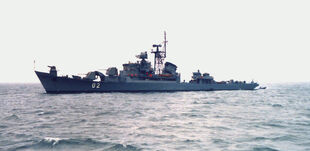
Hämeenmaa in the Gulf of Finland, 1983
Since Doomsday, there has been no construction of new vessels. Instead, many old ships (including the Soviet-built frigate, the FNS Hämeenmaa) have been scrapped to maintain the rest of the navy.
The Finnish navy is currently comprised of the following vessels:
- 2 Finnish-built Turunmaa-class corvette
- FNS Turunmaa
- FNS Karjala
- 3 Finnish-built Pukkio-class minelayers
- FNS Pukkio
- FNS Pansio
- 1 Finnish-built Helsinki-class missile boat
- FNS Helsinki
- 4 Finnish-built Tuima-class missile boats
- FNS Tuima
- FNS Tuuli
- 11 Finnish built Nuoli-class motor gunboats
- Nuoli 1, 2, 3, 6, 7, 10, 11, 13
There is currently talk within the Nordic Union of building a frigate to be operated by the Republic of Finland; this is to replace the FNS Hämeenmaa, which was scrapped in the late 1990s in order to maintain the Finnish Turunmaa-class corvettes.
Equipment[]
The equipment of the Finnish military is almost exclusively either produced in Finland or imported from other Nordic and Atlantic Defense Community nations.
There are two notable arms manufacturers located in Finland, Tampella and SAKO. The SAKO TRG, released in the late 2000s, is the most advanced sniper rifle currently available to many nations in the ADC and is also the only sniper rifle used by the Nordic Battle Group. Additionally, SAKO produces other rifles which are in standard usage in the Finnish Armed Forces.
Tampella began as a linen-producing company in the late 1800s, however it emerged into a widely respected weapons manufacturer, notable for its artillery pieces, in the mid-1900s. Already facing tough times in the years leading up to Doomsday, Tampella would eventually declare bankruptcy in 1987 and start anew with an emphasis solely upon artillery manufacturing. Their 155 GH 52 is one of the primary field artillery pieces used by the ADC and is remarkably portable.
Economy[]
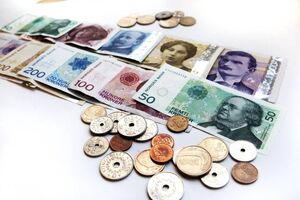
The economy of Finland is one of the most thriving European economies following Doomsday. With no destruction and relative peace since Doomsday, the Finnish economy has managed to stay strong and remain a potent competitor in international business. The Nordic Union as a whole...
The most economically-advanced part of Finland is the Helsinki metropolitan area, which grew in size following Doomsday.
Services[]
Production[]
Finland is a leader in Europe in high-technology manufacturing. This reflects a trend in recent years, which have seen traditional Finnish industries replaced by more modern technological industries.
The traditional production industries in Finland revolve around mining, logging, and creation of paper from pulp. These industries rely heavily upon Finnish natural resources, which are numerous.
The focus on natural resources-based production was dominant up until the late 2000s. At this time, due to greater connections to the Europe, which was worse off than Finland was, a shift in production to a more advanced production industry began to take place.
This modern production industry is mostly comprised of chemical and electronic engineering.
Trade[]
A majority of trade in Finland is directed to other member or observer states of the Nordic Union, with a large minority going to European nations and while some leaves Europe, going primarily to North America but also into other parts of the world. All transactions in Finland use the Nordic Crown (NUK) which was officially adopted on January 1, 2006 as a result of the Stockholm Treaty of 2003.
The Helsingin Pörssi, or Helsinki Stock Exchange (often simplified to HEX) is the primary stock exchange in Finland. Located in the capital city of Helsinki, HEX is where over one hundred Finnish companies are traded; the HEX25 index is based at the exchange and includes such companies as tech-giant Nokia, arms manufacturer SAKO, and Stora Enso, widely reported to be the world's largest paper manufacturer.
Culture[]

This map shows the more-heavily populated parts of Finland
The Finnish culture is extremely unique since it was formed by Uralo-Baltic peoples as opposed to the Germanic peoples that make up the most of Scandinavia. Because of its history and geographic location Finland has been influenced by the adjacent areas' various Finnish and Baltic peoples as well as the former dominant powers Sweden and Russia.
Typical Finnish society is often considered to be made up of ascetic living conditions, a widespread ideal of individualism and self-sufficiency, and egalitarian roots.
Traditions and Customs[]
After Doomsday, many Finns turned to traditional cultures as ways of expressing themselves as a people in a world with extremely little international cooperation. After 1990's foundation of the Nordic Union and eventual reintegration of society that continues to this day, the practice of traditions continued.
The traditions are typically mixes of Protestant Christian tradition and old, pagan Finnic customs. Among these customs are the sauna (a steam-bath) and the mökki (a summer cottage for vacationing).
The three biggest holidays are also mixes of pagan and Christian celebrations. They are Juhannus (Midsummer's Day), Easter, and Vappu (May Day). All of these holidays combine Christian worship with ritualistic dancing, feasting, and bonfires.
Sports[]
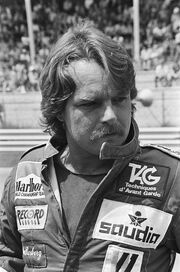
Keke Rosberg, Formula One World Grand Champion 1982
The most popular sports of Finland are ice hockey, ice skating, cross country skiing, and ski jumping. Other popular sports include soccer (which the Finns call football), car racing (especially Formula One-style Grand Prix races), and baseball-like pesäpallo.
The primary league sport in Finland is the ice hockey league, the SM-liiga. Popular Finnish teams compete against other Nordic Teams, and also compete in the IIHF, of which Finland was a founding member in 2005. The most popular team is HIFK, from Helsinki, which was the most recent team to win the SM-liiga Championship, called the Kanada-malja.
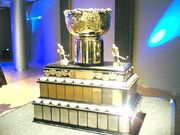
Finland has won five medals in the 2010 Winter Olympics at Zurich, ranking 9th overall, and has won five (one gold, two silver, and two bronze) medals in the 2012 Summer Olympics at Auckland.
Finnish city Tampere bidded to host the 2014 Winter Olympics, which would go on to be held in Trondheim, Norway. Regardless, Finnish teams performed extremely well in that contest.
Music[]
The music of Finland tends to be categorized into folk music, classical music, and modern music (which includes metal and other rock genres).
Folk music of Finland tends to draw from Karelian roots since Karelian music, in the form of the Kalevala, is considered to be the traditional music of Finland prior to Germanic and Russian influences, which have been tried to be repulsed after Doomsday.
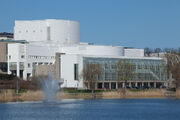
Finnish Opera House, completed 2003
Classical music has recently reemerged in popularity with the Finns. The Finnish Opera House, completed in 2003, was delayed by Doomsday, but its completion has fueled the opera and classical genres to make a comeback in Finland. The Finnish Opera House employs a number of local musicians to write for the Opera House, and many works produces are noted for positivity in addresing the rebirth of civilization after Doomsday.
In addition, metal, which has always had a decent presence in the Scandinavian nations, has continued on strongly. One of the greatest Finnish metal acts is Yöhalu, translated into English as Nightwish, which specializes in a blending of classic, operatic singing with heavy metal music.
Symbols of Finland[]
Flag[]
The Flag of Finland (Finnish: Suomen lippu, Swedish: Finlands flagga), also called siniristilippu ("Blue Cross Flag"), dates from the beginning of the 20th century. On a white background, it features a blue Nordic cross, which represents Christianity. It has not been changed or addapted since 1918 when it was first addapted.
Coat of arms[]
Anthem[]
| |||||||||||||






